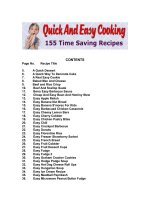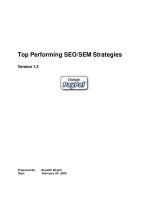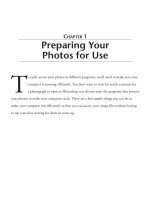quick and dirty seo-sem
Bạn đang xem bản rút gọn của tài liệu. Xem và tải ngay bản đầy đủ của tài liệu tại đây (916.6 KB, 20 trang )
Top Performing SEO/SEM Strategies
Version 1.3
Prepared By: Randall Wright
Date: February 04, 2008
Top Performing SEO/SEM Strategies Page 2 of 18
Table of Contents
Top Performing SEO/SEM Strategies 1
Table of Contents 2
Introduction 4
What Search Engines Want 4
Google Page Rank 4
Relevancy 4
Headline Relevancy 6
Deck Relevancy 6
Creating a Relevant Headline and Deck 6
Body Relevancy 6
Content Theme 7
Example of Tactics from IGN 7
Page Stickiness 8
Making a Site Sticky Using Video 8
Conversational Marketing 9
Outbound, Internal & Inbound Links 9
Increase Investor Awareness 9
Content Delivery Network 10
Static Meta Tags 10
Dynamic Meta Tags (Using PHP) 10
Meta Tag Analyzer 11
Keyword Density 12
META NAME Robots 12
Top Performing SEO/SEM Strategies Page 3 of 18
Outbound Related Links & Inbound Links 13
Page Footer 13
Google Site Maps 13
CreateSitemap.php 14
Pay-Per-Click (PPC) 14
Multivariate Testing 15
Google Analytics 16
Funnel Visualization 18
Summary 18
Top Performing SEO/SEM Strategies Page 4 of 18
Introduction
This eBook has been written to help put a stop to the mysteries of both Search Engine
Optimization and Search Engine Marketing.
What Search Engines Want
Search engines tend to favor straightforward, text-oriented, non-frame, non-tabled, non-
graphically-intensive, non-JavaScript, non-shockwave sites. Unfortunately; this is not what most
online entrepreneurs want to hear.
Search engines love pages that most consumers would agree are non-professional or “ugly”,
but search engine spiders tend to score these "ugly" pages highest, because they are looking
primarily for text content to index. All the fancy stuff like Flash and JavaScript just confuses the
search spider and actually drives it away in some cases.
Google Page Rank
Get to know Google’s technology before starting! This is a useful document to read to learn the
basics of how Google ranks each site it spiders.
://www.google.com/corporate/tech.html
Relevancy
There are a number of ways to establish a page’s relevancy in the eyes of search engines. One
of these methods is called the "on-page factor". On-page factors involve placing your keywords
in strategic locations throughout the pages on your site, so that search engines know to
associate those keywords with a specific web page. Important on-page locations include Header
Tags, Internal Links, External Links, Anchor Text, Bold and Italicized Text, HTML Lists, ALT
Tags, Image Names, Dynamic Bread Crumb, Title, Description, Keywords, Headline, Deck,
Page Body, and Page Name.
Search engines make money by showing ads. In most cases, that’s their entire profit model.
This means that in order to make money, they need to show those ads to as many people as
possible. The method in which they get the largest number of people to use their search engine
is by giving them the most relevant search results.
If the search query, “Make Money” was typed into a search engine, one would expect to see the
very best pages about that specific topic. If the results returned pages about Investment
Opportunities, Vacation Rentals, or ever worse, pages about Viagra and Online Casinos, the
user would probably decide to use a different search engine that could provide more relevant
search results.
Search engines have a vested interest in providing the best, most relevant search results
possible. Otherwise, people could stop using them, and as a result, they would have no one to
show their ads to, and eventually go out of business.
Top Performing SEO/SEM Strategies Page 5 of 18
Another method to establish relevancy are "off-page factors". These are the factors related to
the pages that link to the site from other sites. Off-page factors include the inbound link anchor
text, the text in the paragraphs surrounding that anchor text, the titles of the pages linking to the
page, the other on page factors of the pages that link to the page, the directory categories the
site is found in, the directory categories of the sites linking to the page, and many other factors.
Of the off-page factors, the inbound link anchor text is the most important, but they all play a
role. Some search engines are more advanced than others, and make more complete use of
this data; however, all of the major search engines are moving towards applying this data in
order to increase the quality and relevancy of their search results.
Simply put; the topic of and theme of the page MUST be built around the keywords and key
phrases you are targeting. If you are writing long sales copy, this is very difficult task to perform
with without making the content read funny. In this case you would only focus on the first 5-10
paragraphs or the eye catcher.
A webmaster should always follow acceptability guidelines for each search engine. Review
these guidelines and become familiar with them.
Google Guidelines:
://www.google.com/Webmasters/guidelines.html
Yahoo Guidelines:
://help.yahoo.com/help/us/ysearch/basics/basics-18.html
Ask Guidelines:
://about.ask.com/en/docs/about/editorial_guidelines.shtml
DMOZ Guidelines:
://www.dmoz.org/help/submit.html
Their advice is to generally create content for the user; not the search engines – to make
content easily accessible to their spiders and to not try to trick their system. Webmasters often
make critical mistakes when designing or setting up their web sites, inadvertently "poisoning"
them so that they will not rank well.
Coding guidelines published by the World Wide Web Consortium (
://www.w3.org/) should be
followed as well as tested using their free valuator which checks the markup validity of Web
documents in HTML, XHTML, SMIL, MathML, etc. (
://validator.w3.org/)
If the acceptability and coding guidelines are followed, and the site presents frequently
updated, useful, original content, and a few meaningful, useful inbound links are established. It
is very possible to obtain a significant amount of organic search traffic.
When a site has useful content, other Webmasters will naturally place links to the site,
increasing its Page Rank and flow of visitors. When visitors discover a useful web site, they tend
to refer other visitors by emailing or instant messaging links.
As a result, practices that improve web site quality are likely to outlive short term practices
that simply seek to manipulate search rankings. Relevant, useful content will ensure you will
always come out on top!
Top Performing SEO/SEM Strategies Page 6 of 18
Headline Relevancy
The headline of the article should be created as a keyword phrase using as little junk words as
possible. A junk word is a word that gets in the way of the deck message and dilutes the
relevancy of the message. A few examples of these junk words are: the, and, if, at, about, & of.
If someone is searching for the phrase "Corn Commodities" an article or page that has been
optimized for that exact phrase will gain higher ranking in the search engines than “Coy About
Corn Commodities” because the words "Coy About" are not getting in the way and diluting the
exact search term "Corn Commodities".
Deck Relevancy
The deck is a summary of the title; somewhere inside this summary should be your keyword
phrase without using too many junk words. If you are using the words "Corn Commodities" in
the title, use it in the deck as well.
Creating a Relevant Headline and Deck
(WRONG)
Page Headline:
The Easy Way To Create Your OWN Money Making Internet Business
Deck:
Get access to absolutely ALL of the tools, resources, and expert support you need to
start your own BOOMING, fully-automated Internet business from scratch.
(RIGHT)
Page Headline:
Create Your OWN Money Making Internet Business
Deck:
Access to ALL of the tools, resources, and expert support needed to start your own
BOOMING, fully-automated Internet business.
Body Relevancy
The body of the page is a very important part of search engine optimization.
Many search engines like Google "strip" the body text and use it to not only to display sections
in their search results, but they also use the body text to determine the subject matter of each
page, determine which words and phrases are used the most, and assigns a theme to the page.
This way; the most relevant sites are found in their search results.
Top Performing SEO/SEM Strategies Page 7 of 18
Content Theme
The content writer needs to apply a keyword theme to each page. In order to apply a keyword
theme you must keep a very distinct set of keywords to use on that page. The theme must flow
through the Title, Description, Keywords, Headline, Deck, Page Body, Links, and Page Name.
The following wire frame is an example of a highly optimized page which include keywords in
the Website title, slogan, bread crumb, page title, page deck, page body, and page footer.
Other keyword elements can be added to navigation, news headlines, blog headlines, external
links and advertising. When combined with highly relevant Meta title, description, and keywords
the relevancy score will increase and search listings will appear higher in search results.
Example of Tactics from IGN
An excellent way to increase on page keyword density is to use a minimal amount of text on the
description page while maximizing the keyword usage.
Top Performing SEO/SEM Strategies Page 8 of 18
This tactic is used by many large websites such as IGN to maximize the keyword density.
Page Stickiness
Sticky content refers to content published on a website, which has the purpose of getting a user
to return to that particular website or hold their attention and get them to spend longer periods of
time at that site.
When you perform a Google search and click on one of the listings, Google measures how long
you stay at that website before clicking back. If Google notices that most of the visitors they are
sending to your website are clicking the back button, your page stickiness score goes down. On
the other hand, if Google notices that most of the visitors they are sending to your website stay
on your website, your page stickiness score goes up. This page stickiness score is included in
your overall Page Quality Score.
Making a Site Sticky Using Video
In recent studies, a simple 60 second video on your landing page can increase page rank
immensely.
What this does is engages the audience for 60 seconds and keeps the visitor on your landing
page while increasing page stickiness. Host all video you create on a video hosting service such
as YouTube.com to save money in network bandwidth and to keep your website running fast.
Top Performing SEO/SEM Strategies Page 9 of 18
Video content can slow a site down to a crawl, it is very important to have a fast website at all
times.
Conversational Marketing
Use Conversational Marketing tactics. Conversational Marketing is the engagement of social
media by a corporation to promote their product or brand. It differs from traditional forms of
"customer touch" because the company may enter into an online dialogue which is stored
publicly in a forum or blog. The company may also take the conversation offline.
Conversational Marketing is nothing new. It’s basically the concept that people respond better to
lowered voices spoken in credible tones than they do to the aggressive in-your-face marketing
speak as is evidences in everything from TV ads to the pap-lingo of so many websites.
Conversational Marketing is about bringing conversations stemmed by online debate to a more
sensible, less aggressive approach.
Outbound, Internal & Inbound Links
Outbound related links should be added to the links section of each page or the use of page
content to external related pages are also highly recommended.
Internal keyword links are links that are directly related to the content on the current page and
off page. Every mention of a popular keyword should be linked to an internal article that is highly
optimized for that keyword or term.
Inbound links should be added to the footer of your any other websites that you own.
Approaching article writers from other reputable websites should be contacted and a long term
relationship should be formed based on news and events that could be fed to interested writers.
Over time, this will keep a steady stream of inbound traffic from these websites while increasing
the popularity score.
Increase Investor Awareness
Investor awareness can be added to any web marketing initiative by developing a series of pitch
pages with recent internal and industry related news focusing on the benefits of investing in a
particular public company. These pitch pages should include a very simple form to gather the
first name, last name, and email address of the interested investor.
This information will be added to a database of potential investors and contacted with exciting
information and monthly newsletters to spark investment.
Top Performing SEO/SEM Strategies Page 10 of 18
Content Delivery Network
The user's proximity to your web server has an impact on response times. Deploying your
content across multiple, geographically dispersed servers will make your pages load faster from
the user's perspective. But where should you start? Remember that 80-90% of the end-user
response time is spent downloading all the page, images, style sheets, scripts, Flash, and
videos.
A content delivery network is a collection of web servers distributed across multiple locations to
deliver content more efficiently to users. The server selected for delivering content to a specific
user is typically based on a measure of network proximity. For example, the server with the
fewest network hops or the server with the quickest response time is chosen.
Some large Internet companies own their own Content Delivery Networks, but it's cost-effective
to use a Content Delivery Network service provider, such as Akamai Technologies, Mirror
Image Internet, or Limelight Networks.
For start-up companies and private web sites, the cost of a Content Delivery Network service
can be prohibitive, but as your target audience grows larger and becomes more global, a
Content Delivery Network is necessary to achieve fast response times. At Yahoo!, properties
that moved static content off their application web servers to a Content Delivery Network
improved end-user response times by 20% or more. Switching to a Content Delivery Network is
a relatively easy code change that will dramatically improve the speed of your web site.
Static Meta Tags
Static Meta tags should be used where there either is no on page dynamic content or the end
result is better than using Dynamic Meta Tags. Using static Meta tags gives you more control
over the end result but also increases workload significantly. Use the following set of META
controls when editing the page source.
<TITLE>title here</TITLE>
<META NAME="Description" CONTENT="content here">
<META NAME="Keywords" CONTENT="content here">
<META NAME="author" content="author here">
<META NAME="copyright" content="company here">
<META NAME="language" content="en-us">
<META NAME="rating" content="General">
<META NAME="robots" content="index,follow">
<META NAME="revisit-after" content="7 Days">
<META http-equiv="pragma" content="no-cache">
Dynamic Meta Tags (Using PHP)
Dynamic Meta Tags are used when there is a dynamic element on the page such as a title,
deck, and page body. In the example below, the fields, Profile_Name, Profile_Symbol,
MetaDesc, and MetaKeywords are used to populate the title with a public company name, and
Top Performing SEO/SEM Strategies Page 11 of 18
exchange symbol. The description is populated with the first 150 correctors of the deck and the
keywords are being populated with the company name and the first 100 characters of the deck.
Use the following set of META controls when editing the page source. (Edit to your
requirements)
$Profile_ID = $company_profile['ID'];
$Profile_Name = $company_profile['Name'];
$Profile_Symbol = $company_profile['Symbol'];
$Profile_Exchange = $company_profile['Exchange'];
$Profile_Description = $company_profile['Description'];
$MetaDesc=substr($Profile_Description, 0, 150);
$MetaKeywords=substr($Profile_Description, 0, 100);
<title><?php echo "$Profile_Name"; ?> - <?php echo "$Profile_Symbol"; ?></title>
<META NAME="Description" CONTENT="<?php echo "$MetaDesc"; ?>">
<META NAME="Keywords" CONTENT="<?php echo "$Profile_Name"; ?>, <?php echo
"$MetaKeywords"; ?>">
<META NAME="author" content="author here">
<META NAME="copyright" content="company here">
<META NAME="language" content="en-us">
<META NAME="rating" content="General">
<META NAME="robots" content="index,follow">
<META NAME="revisit-after" content="7 Days">
<META http-equiv="pragma" content="no-cache">
Meta Tag Analyzer
Use a Meta Tag analyzer to analyze your relevancy for every page in the site. The goal is to
achieve as close to 100% keyword relevancy between all page elements as possible. As
mentioned earlier, assign a theme to each page; keep the theme flowing through the Title,
Description, Keywords, Headline, Deck, Page Body, Links, and Page Name. When you are
certain that the site has been developed in this manner, run the page through a Meta Tag
Analyzer and remove or ad words phrases to the page focusing on strengthening the theme.
Top Performing SEO/SEM Strategies Page 12 of 18
Keyword Density
Keyword density is the measurement of how many times a single word or phrase is found within
all page text on that page. The example below shows us that the keyword "madden" has been
found 39 times and is measured at 2.53% keyword density.
The goal is to get between 4% - 6% keyword density for a single keyword, 2% - 3% keyword
density for a 2 keyword phrase, and 1.5% - 2% for a 3 keyword phrase. When you keep the
keyword density between these percentages, you will be sure not to over stuff, and under utilize
your keywords.
META NAME Robots
The content of the Robots META tag contains directives separated by commas. The currently
defined directives are [NO]INDEX and [NO]FOLLOW.
The INDEX directive specifies if an indexing robot should index the page.
The FOLLOW directive specifies if a robot is to follow links on the page.
The defaults are INDEX and FOLLOW.
The values ALL and NONE set all directives on or off: ALL=INDEX,FOLLOW and
NONE=NOINDEX,NOFOLLOW.
Some examples (more examples can be found by Googling the phrase 'Robots META tag'):
<meta name="robots" content="index,follow">
<meta name="robots" content="noindex,follow">
<meta name="robots" content="index,nofollow">
<meta name="robots" content="noindex,nofollow">
Top Performing SEO/SEM Strategies Page 13 of 18
Outbound Related Links & Inbound Links
Outbound related links should be added to the links section of each page. Each page should
contain links that are directly related to the content on page and off page. Inbound links should
be added to the footer of your any other websites that you own.
Page Footer
Internal and Outbound links should be added to the footer of every page. These links assist the
search engines in indexing pages that are not on regular navigation. This section also allows
you to increase the amount of inbound links to other websites you operate.
Google Site Maps
The Sitemap Protocol allows you to inform search engines about URLs on your websites that
are available for crawling. In its simplest form, a Sitemap that uses the Sitemap Protocol is an
XML file that lists URLs for a site.
The protocol was written to be highly scalable so it can accommodate sites of any size. It also
enables webmasters to include additional information about each URL (when it was last
updated; how often it changes; how important it is in relation to other URLs in the site) so that
search engines can more intelligently crawl the site.
Sitemaps must be created in XML format (see example below), uploaded to your web server,
and submitted using your Google Webmasters account.
://www.google.com/webmasters
Site Map Example:
Top Performing SEO/SEM Strategies Page 14 of 18
CreateSitemap.php
If a great deal of content is stored in a database, you can create a small script that will query the
database and build most of the Sitemap for you. The following PHP code will create XML
Sitemap content using PHP.
Pay-Per-Click (PPC)
Pay-per-click, or PPC, is an advertising technique used on Web sites, advertising networks, and
search engines.
With search engines, pay-per-click advertisements are usually text ads placed near search
results; when a site visitor clicks on the advertisement, the advertiser is charged a small
amount. Variants include pay for placement and pay for ranking. Pay-per-click is also
sometimes known as Cost per Click (CPC).
While many companies exist in this space, Google AdWords and Yahoo! Search Marketing,
which was formerly Overture, are the largest network operators as of 2006. MSN has started
beta testing with their own PPC services MSN adCenter.
Top Performing SEO/SEM Strategies Page 15 of 18
Depending on the search engine, minimum prices per click start at US$0.01 (up to US$2.00).
Very popular search terms can cost much more on popular engines. Abuse of the pay-per-click
model can result in click fraud.
As of 2005, notable PPC Keyword search engines include: Google AdWords, Yahoo! Search
Marketing, GaZabo.com, Miva, which was formerly FindWhat, SearchFeed, Enhance (formerly
Ah-Ha), GoClick, 7Search, Kanoodle, ePilot, Search123, Kazazz, Pricethat, Search FAST and
others.
An industry of professional services firms that can assist advertisers in marketing their products
and services on search engines has also developed. Many of these firms will be members of
various trade bodies such as IABUK, SMA-UK and SEMPO, while other reputable firms have
chosen to avoid these bodies, as many of them remain heavily biased toward the firms that first
got together and founded them.
This technique is very much like an auction and is sometimes called “Click Wars”. When setting
up a CPC campaign it is VERY important to understand that you can be out bid and your cost
per click can increase which will result in depleting your daily budget, driving down your click
through rate as we all know reduces the amount of your daily visitors, thus reducing your overall
sales.
A CPC campaign does NOT guarantee you a spot on the search results. If your campaign has
been outbid, your ad can come up in second place or not at all. If this is the case, you have a
few choices such as increasing your monthly budget or optimize your Web site to increase your
quality score.
PPC engines can be categorized in "Keyword", "Product", "Service" engines. However, a
number of companies may fall in two or more categories. More models are continually being
developed. Currently, pay-per-click programs do not generate any revenue from site traffic to
The Wright Approach to SEO & SEM, Trademarked 2006 Page 35 of 61 sites using these
programs. Only when visitors click on banner advertisements or pop-ups is revenue generated.
We are going to focus on “Keyword CPC” SEO marketing.
Search engine marketing is a product where the search engine company charges fees related
to inclusion of Web sites in their search index. Paid inclusion products are provided by most
search engine companies such as Yahoo!, Google and Ask.
The fee structure is usually based on a bidding system similar to eBay.com. A user signs in and
applies keywords to ads that have been created by the user. You then set your maximum bid
and for each ad group you create which will ensure you are placed at the top of each search
results page. This is the part the most people have been making there mistakes while using a
PPC system such as Google AdWords and Yahoo Marketing.
Multivariate Testing
Multivariate testing is usually employed in order to ascertain which content or creative variation
produces the best improvement in the defined goals of a website, whether that be user
registrations or successful completion of a checkout process (that is, conversion rate).
Top Performing SEO/SEM Strategies Page 16 of 18
Dramatic increases can be seen through testing different copy text, form layouts and even
landing page images and background colors. However, not all elements produce the same
increase in conversions, and by looking at the results from different tests, it is possible to
identify those elements that consistently tend to produce the greatest increase in conversions.
Google Analytics
Google Analytics is a free service offered by Google that generates detailed statistics about the
visitors to a website. Its main highlight is that the product is aimed at marketers as opposed to
webmasters and technologists from which the industry of web analytics originally grew.
Google Analytics can track visitors from all referrers, including search engines, display
advertising, pay-per-click networks, email marketing and digital collateral such as links within
PDF documents.
Integrated with AdWords, users can review online campaigns by tracking landing page quality
and conversions (goals). Goals might include sales, lead generation, viewing a specific page, or
downloading a particular file. These can also be monetized. By using Google Analytics,
marketers can determine which ads are performing, and which are not, providing the information
to optimize or cull campaigns.
Google Analytics' approach is to show high level dashboard-type data for the casual user and
more in-depth data further into the report set. Through the use of GA analysis, poor performing
pages can be identified using techniques such as funnel visualization, where visitors came from
(referrers), how long they stayed and their geographical position. It also provides more
advanced features, including custom visitor segmentation.
Google Analytics is a very powerful free tool, take advantage of powerful tools like Google
Analytics as much as you can. Competitors can cost upwards of hundreds of thousands of
dollars a year.
://www.google.com/analytics/home/.
Google Analytics does not only track Google traffic, but it tracks all traffic including Yahoo! PPC
campaigns and all organic and paid traffic you can think of. Google Analytics tells you
everything you want to know about how your visitors found you and how they interact with your
site. You'll be able to focus your marketing resources on campaigns and initiatives that deliver
ROI, and improve your site to convert more visitors.
The enterprise level of Google Analytics has capabilities you'd expect from a high end web
analytics systems and it also provides timesaving integration with AdWords. Of course, Google
Analytics tracks all of your non-AdWords initiatives as well.
With Google Analytics, you can get started today creating targeted, ROI-driven marketing
campaigns and improving your site design and content and it will not cost you a dime. In the
following example, you would replace the Web Property ID "UA-#######-#" (Highlighted in
Yellow Below) with your unique Web Property ID that Google Analytics assigned your website
when you added a new account.
Top Performing SEO/SEM Strategies Page 17 of 18
Paste the following JavaScript into all the web pages you want to track just before the closing
</body> tag.
Get executive summaries of traffic, e-commerce, and conversion trends without hunting through
reports. Quickly identify problem areas. Compare revenue, conversions, campaigns, and
keywords at a glance. Google Analytics Executive, Marketer, and Webmaster dashboards give
you clear answers, fast, in an easy-to-digest visual format.
Top Performing SEO/SEM Strategies Page 18 of 18
If you have an AdWords account, you can access Google Analytics directly from your AdWords
interface. Google Analytics also saves you time by automatically importing all your keyword data
from AdWords.
So you see ROI and other key metrics for every keyword you buy on AdWords, with no extra
effort on your part, just by using Google Analytics.
Funnel Visualization
It happens all the time. Visitors are excited about what you're offering, race through the first few
steps in the conversion process, and then abruptly exit your site. It's baffling, but it doesn't have
to be.
The Google Analytics Funnel Visualization feature shows you the bottlenecks in your conversion
and checkout processes - attributable to such factors as confusing content or maze-like
navigation - so you can eliminate or work around them, and start funneling visitors through the
steps you want them to take, all the way through to conversion.
Summary
Practices that improve Web site quality are likely to outlive short term practices that simply seek
to manipulate search rankings. Relevant, useful content will ensure you will always come out on
top!
Affiliate Marketing Tools and Resources
Domain Registration
Hosting
statistics tools.
Website Editors
DreamWaver
– is professional HTML editor, ideal for work with MoreNiche
templates.
XSitePro – great tool for creating little review websites for marketers with no
knowledge of design and HTML. This tool can’t be used with free MoreNiche
templates as it has limited layouts.
Photo Editing Software
Adobe PhotoShop – professional photo editing software.
Keyword Research Tools
KeywordElite – is desktop tool with many keyword research features. This tool
will collect you keywords from various places into numbers of thousands. It is
used by most top SEO and PPC marketers.
Copyright © MoreNiche affiliate program
for $6.99 instead off $8.99
1&1 Domain Sales - Stop paying too much for domains! 1&1 sells .com domains
PowWeb - FREE 2 Years Domain Registration when you purchase 2 years of hosting
Super Green Hosting is the leader in international green hosting. Prices start at only $4.95/mo
for Unlimited Space, Free Domain and Free Setup!
BlueHost starts at $6.95 for Unlimited Space, Unlimited Transfer and Unlimited Domains.
A great solution if you're always looking to expand your business.
HostGator – hosting service with CPanel, WordPress friendly, scripts and
WebHostingBuzz – use coupon code "ICE" and get 50% off hosting RIGHT NOW!
keyword research and suggestions.
Search Engine Optimization
SeoElite – is one of most popular SEO tools with multiple functions, from
competition research down to automatic link exchange approaches and more.
Email Marketing Tools
Aweber – one of the best email marketing services – allows capturing emails,
creating multiple campaigns, double opt-in function, great partnership with major
internet providers to ensure your emails gets delivered and read.
Copyright © MoreNiche affiliate program
WordTracker – most popular online keyword research service, offers advanced
Join MoreNiche Now!









